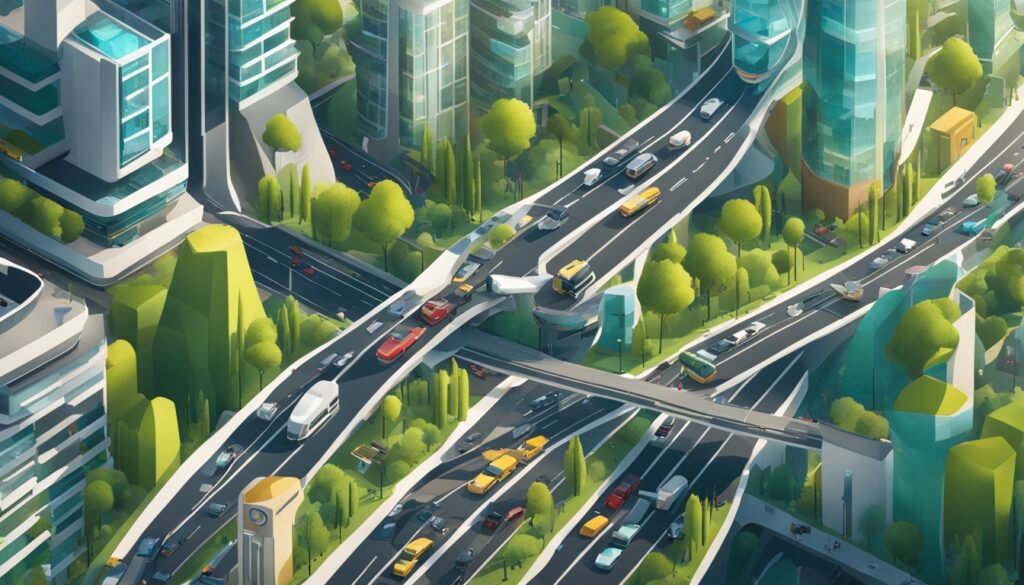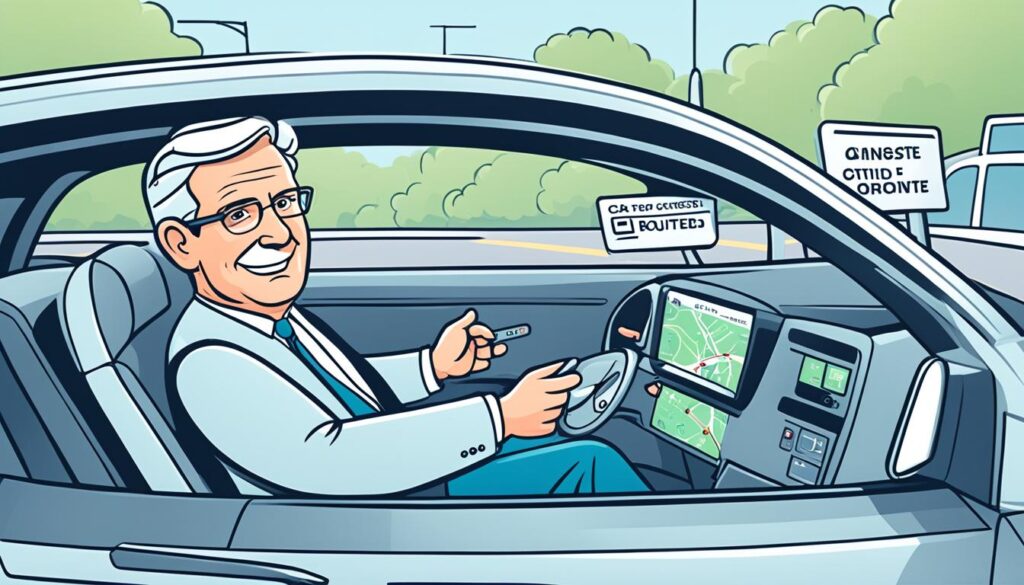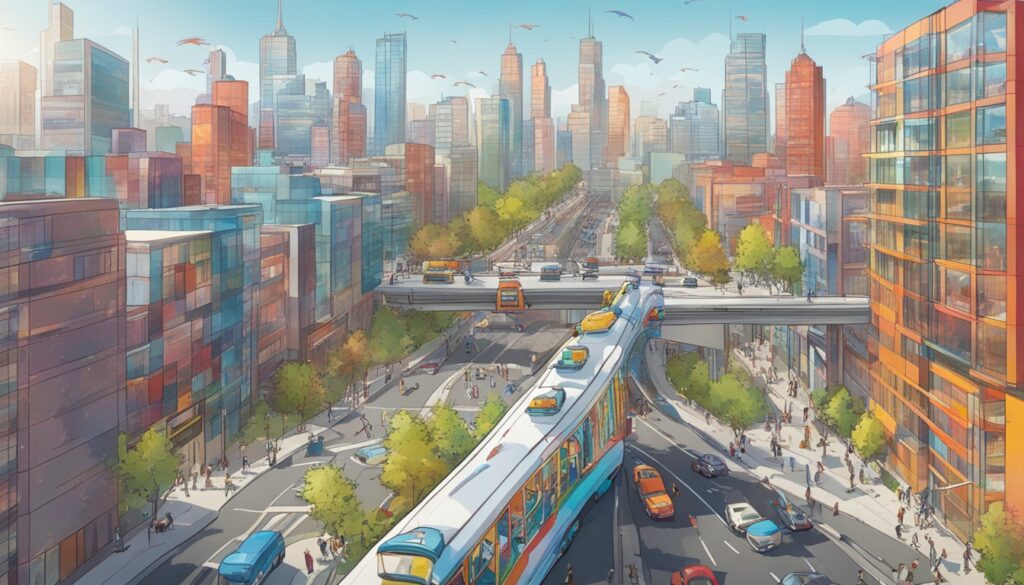Did you know by 2050, nearly 68% of the world’s people will live in cities? This fact shows how vital AI is for better city planning and improving life in cities. Smart cities use AI to make things more efficient and accessible, especially for middle-aged folks.
Smart cities with AI are not new. Since 2008, AI has been a key part of city planning, helping with global sustainable development. Governments see public safety and better quality of life as top goals for smart cities. They also aim to improve city services with AI in urban planning.
Cities like Lisbon use digital twins to get ready for floods. London focuses on digital access, bringing in fiber and 5G for everyone. Philadelphia has a permit navigator program that gives important info and cost details for permits for homes and businesses.
Looking into how AI makes cities smarter for middle-aged people shows AI’s big impact. It helps with things like better bus routes and smart parking spots. Projects from GE, Google Sidewalk Labs, and Microsoft CityNext show how far we’ve come in making cities smarter with AI.
Introduction to AI in Smart Cities
Urban areas are growing fast, making it key to use AI in city planning. AI changes how we build cities, use resources, and improve life for people living there. It helps with traffic, crime prevention, and saving energy, making cities safer, greener, and more efficient.
Overview of AI Technology in Urban Planning
AI is changing the game in city planning. In places like Pittsburgh, Moscow, and Singapore, AI helps manage traffic by using data from cameras, sensors, and GPS. This tech makes traffic flow better by changing routes and traffic lights in real-time, cutting down on congestion.
Projects like Sidewalk Labs in Toronto and Singapore’s Virtual Singapore use AI for traffic, environment, and city services. AI lets cities create digital copies of themselves for testing and improving planning and services.
Key Drivers of Smart City Development
Smart cities aim for better safety, sustainability, and quality of life. AI helps police and emergency services by predicting where they’re needed, like in Dubai and Nashville. It also uses video analytics for better security, as seen in New York City.
For the environment, cities like Barcelona use over 20,000 sensors to track pollution, noise, and traffic. AI balances energy use, adjusts prices, and controls devices to lessen harm to the environment.
Importance of AI for Middle-Aged Residents
AI is great for middle-aged people by making cities more accessible, improving healthcare, and making life better. It helps with public transport, making it easy and reliable for seniors. AI also helps in healthcare by predicting and monitoring health issues in real-time.
AI creates safe and easy-to-use environments with better surveillance and services. It meets the needs of middle-aged people, making their city life better.
Smart City Solutions for the Middle-Aged Population
Modern cities are changing fast, and they need to meet the needs of everyone, especially the middle-aged. These people are key to city life. By using smart city tech, they get to enjoy new tech in things like public services, transport, and city services.
AI-Powered Public Transportation
AI is changing how we move around cities, making it better and more reliable. It helps with on-demand transport and finding the best routes. This cuts down waiting times and makes getting around easier.
Cities like Philadelphia and New York are using AI to give real-time info on public transport. This makes it easier for the middle-aged to get around without hassle.
Intelligent Intersections and Traffic Management
Smart traffic lights and AI help reduce traffic jams and make roads safer. They use live data to change traffic lights and manage traffic better. In Hangzhou, China, AI has made traffic 3%-11% faster.
This means smoother and safer trips for the middle-aged, making city life better for them.
Enhanced Public Services and Accessibility
AI is also making public services better and cities more accessible. Cities are using tech to make things like getting permits easier, like in Philadelphia’s permit navigator. This helps improve services for everyone.
By using AI, cities can offer services that help the middle-aged population. This makes life in the city better for them.
Impact of AI on Urban Infrastructure
AI technology is changing urban infrastructure fast. Cities are using AI to make better use of data and improve how things work. This makes life better for people living there.
Data Collection and Connectivity
Smart cities use lots of sensors and IoT devices to collect data. By 2020, there were about 50 billion connected devices worldwide, including a billion cameras sending data to AI systems. This data helps cities plan better and improve services.
China has made big improvements in six cities with smart city projects. This has made life better for people there.

AI helps cities use resources better, track pollution, and keep people safe. Connected devices with AI can check on infrastructure, fixing problems before they get worse.
Edge Computing in Mission-Critical Applications
Edge computing applications are key for urgent situations where quick decisions are needed. They cut down on delays, helping cities manage traffic, safety, and more efficiently. Research shows AI can predict traffic, making cities move smoother.
AI Analytics for Predictive Maintenance
AI analytics for predictive maintenance changes how cities look after their infrastructure. AI looks at past and current data to guess when things might break, so they can fix them before they do. This cuts down on problems and makes things last longer.
Using AI for maintenance makes things run better and is better for the planet. Studies have shown how AI can help save energy in cities, making them greener. With more people moving to cities, AI will play an even bigger role in keeping them running smoothly.
How AI is Shaping Smarter Cities for Middle-Aged Residents
Artificial Intelligence (AI) is changing cities for the better, especially for middle-aged folks. As cities grow, with more people moving in, AI is key to making them better. It helps with daily commutes, healthcare, and making places fun and social.
Optimizing Daily Commutes and Transportation
For middle-aged people, getting to work or school can be tough. Traffic and unreliable buses or trains are big problems. But AI is changing this. It uses smart traffic systems and predicts traffic to cut down travel time and make getting around easier.
Companies like Siemens and IBM are working on making public transport better with AI. This means safer and on-time rides for everyone.

Improving Healthcare and Emergency Response
AI is also making cities smarter in healthcare and emergencies. It can look at lots of data fast, helping predict health issues before they get worse. In emergencies, AI helps by finding the best routes for ambulances and predicting where emergencies might happen.
Big companies like Google Health and Microsoft are leading the way in using AI for better healthcare and faster emergency responses.
Enhancing Recreational and Social Spaces
AI is also making parks and social areas better. It helps keep people safe and makes places more fun. For example, some parks in Las Vegas use sensors to watch over the area and keep everyone safe.
This makes parks safer and more enjoyable for everyone. It also helps build a stronger community feeling.
Innovations in Urban Development for Middle-Aged Individuals
Recent changes in city design are making cities better for middle-aged people. By using AI, these urban design advancements with AI improve how people move around and feel. Cities are now making sure life is lively and easy to get around for middle-aged folks.
AI helps make city living better by tailoring it to each person. Middle-aged friendly smart city initiatives use AI to make public services quicker and more focused on what people need. This means better public transport and traffic management, making it easier for middle-aged people to get around.
AI also changes how cities are maintained and collects data in real-time. Urban design advancements with AI include smart energy systems and lights that adjust automatically. These techs make cities more sustainable and safe for middle-aged folks.
Thanks to global examples and the European Commission’s smart city plans, cities are getting better at using digital tech. This means better services and networks for everyone, especially middle-aged people. It’s all about making cities that are not just smart but also caring and welcoming.
These changes are key to making cities that are smart, kind, and open to everyone. As more people live in cities, these updates make sure middle-aged folks have a good life in the city.
Benefits of AI Technology in Urban Areas
AI technology brings many benefits to urban areas, especially for middle-aged residents. It improves safety, sustainability, and quality of life. These advancements make cities better places to live.
Safety and Security Enhancements
AI has changed how cities handle safety and security. It makes predicting crimes more accurate, helping police use their resources better. For example, the Seattle Police Department uses data analytics to make smarter decisions.
AI also cuts down emergency response times by about 40%. This makes cities safer for everyone.
Sustainability and Environmental Health
AI is key to keeping cities green and healthy. Tools like digital twins and smart waste management systems help monitor and protect the environment. These technologies are crucial in managing big environmental challenges like the Rainforest fires and the 2020 Australian bushfires.
AI helps cities prepare for and handle disasters better. It supports energy-saving programs, which is good for the environment.
Quality of Life Improvements
AI makes life better for middle-aged people in cities. It improves public services and makes things more accessible. For example, AI-powered public transport reduces the need for face-to-face meetings by 80%.
Recreational areas also get a boost from AI, making cities more enjoyable. Free public Wi-Fi and smart services make life easier and more fun for city dwellers.
Conclusion
AI has changed urban life, especially for middle-aged people. Cities now use advanced AI to offer better services and improve their infrastructure. For example, Freetown, Sierra Leone, has used AI to grow more trees and create jobs, showing how AI can make cities healthier and more sustainable.
Smart city tech is making the future look bright for middle-aged folks. It’s making public transport smarter and traffic flow better. Projects like Singapore’s Green View Index and Barcelona’s sensor use show how AI can improve the environment and quality of life.
Also, self-driving cars from Waymo and AI-controlled traffic lights in Hangzhou are making cities safer and more efficient. This shows how AI is changing urban mobility for the better.
The future looks good for middle-aged people in smart cities. With more people moving to cities, we need more AI innovation to keep them safe and sustainable. AI can help manage resources better, check on infrastructure, and share information efficiently. This means cities could become healthier, safer, and more lively places for everyone.
